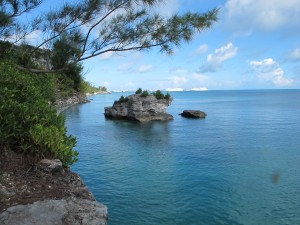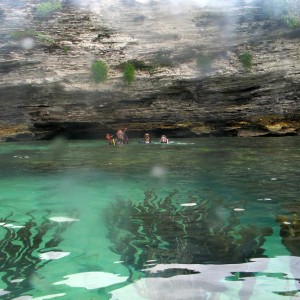The water was so clear I could see the coral colonies on the reef below the boat. From dark clouds in the south, I heard a rumble of thunder. Dylan, our boat captain, eyed the horizon. “It’s okay for now,” he said.

I had come to Bermuda for two weeks of fieldwork: collecting water samples showing the effects of groundwater discharge on the reef, and assessing its impact on coral colonies nearby. I had two weeks to bring together the essence of my summer research project. Sun or storm, out we went.
On this particular day, I was collecting water samples with Tori, a Princeton grad student, and assisting two divers as they sampled the coral colonies.
Donning my snorkel and fins, I swam over to check on the divers. I was underwater, watching them carefully extract a coral sample, when it started raining. From below, I watched the water’s vast expanse erupt in a textured tessellation, repeated as far as I could see. Those first moments of that day’s downpour are one of my summer’s most transcendent memories.

Perhaps I also remember that moment so vividly because of the chaos that followed.
I drifted up, still in a dream. But when I reached the surface, our boat was moving.
I mean, moving.
Across the turbulent water, I could see Dylan running frantically about the boat. He yelled something; I could just make out a few of his words over the wind: “The anchor slipped!”
“WHAT DO WE DO?!” I hollered, panic rising. The waves were pushing the boat towards the cliffs. It was over the reef, where the water was shallowest, and the motor might, at any moment, smash against the rocks – leaving us powerless to the sea.
“DO ANYTHING!” Dylan yelled back. “GRAB THE ANCHOR AND SWIM WITH IT!”
I looked down into the rolling water and saw the anchor dragging across the sand. This is it, I thought. I pulled the anchor to the surface. Tori grabbed hold of the other side. I kicked with my fins, pulling long arm strokes with my left hand while my right clutched the anchor. Tori pulled furiously alongside me.
What else could I do? In that moment, all I had was my body – my thumping, adrenaline-powered heart, gasping lungs, thrashing legs, and splashing one-armed stroke – and it was up to me to hold the boat off the rocks. I kept throwing stroke, stroke, stroke, accompanied by frantic kicks.
We were sliding backwards.
My thoughts in that moment were not the kind of thing you can publish on a research blog.
I glanced back. The boat was floating two feet from the reef crest. Dylan had jumped overboard, and was standing on the reef, barefooted, holding the boat off the rocks.
“COME PUSH!” he yelled.
I dropped the anchor and swam back to the boat. Using the rocky bottom for leverage, I pushed while Dylan jumped aboard and started the motor. With just enough depth to turn, the prop spun furiously, and the boat surged away from the reef and out to safety.
Later, we found many things to laugh about. We were safe, the boat was fine, and our coral samples were tucked in the cooler.
Looking back, this was certainly my summer’s most stressful, memorable, and potentially disastrous experience. And, in retrospect, it also epitomizes much about my experience of independent research. The feeling of it is up to me to make this happen was present every day in the field: I had to find a field site; collect the water samples; make the decisions – only I could bring my project together. At my side were extraordinary resources, mentors, and collaborators – incredible people like Tori and Dylan – and I owe them everything. But it was my place to set goals and take initiative in carrying out the project, to carry the responsibility that is the essence of “independent work.”
The feeling of it is up to me to make this happen was present every day in the field
This responsibility poses a constant challenge to do whatever it is that might save the boat. This doesn’t make for idle days or a tranquil mind. But this feeling is also the deepest, most unshakeable motivation for research. Independent work is a little bit of saving the boat every day – and sometimes a lot of saving the boat, just when we least expect it. That is why it is so challenging, why we come into the lab on weekends, or stay up to read one more paper that might illuminate it all.
As my aching legs and left arm attested the following day, I have never swum so hard as when I pulled that boat. And this is the impetus that spurs us on and brings us back for more. It is what allows us, with much help, and floundering, and failure, to move our research out to ever deeper waters. It is pulling the boat that brings research – and us – alive.
Swim on!
— Zoe Sims, Natural Sciences Correspondent

